Ebi Sushi
A Comprehensive Overview of Prawn or Shrimp in Japanese Sushi Cuisine
エビすし 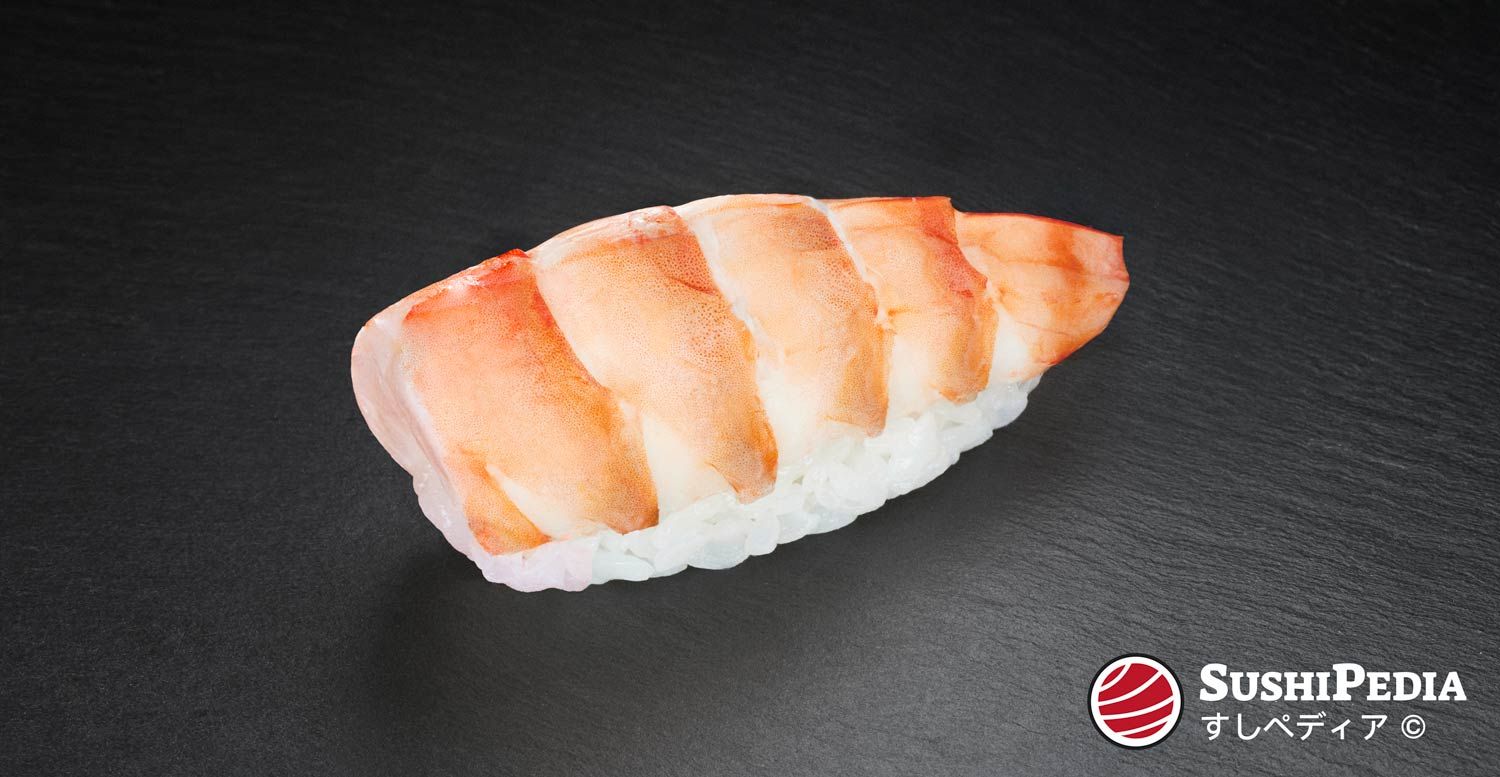
What is Ebi?
In the Japanese language, the term ebi エビ is used to describe prawns or shrimps. This classification includes a variety of species found in different aquatic environments, from shallow coastal waters to the deep areas of the ocean.
In Japanese cuisine, the turmeric prawn, often used as the synonym ebi, plays a central role. However, it is important to emphasize that the term ebi does not exclusively refer to turmeric prawns. Lower-priced types of prawn are frequently used, particularly in “cheaper” restaurants. There are other types of shrimp that are important for traditional Japanese cuisine and especially for sushi. In Japan, ebi is considered one of the traditional and high-quality representatives of edomae-style sushi. Some refer to ebi as one of the ‘kings of sushi’ due to its good flavor and beautiful appearance.[1]
Ebi for Sushi or Sashimi
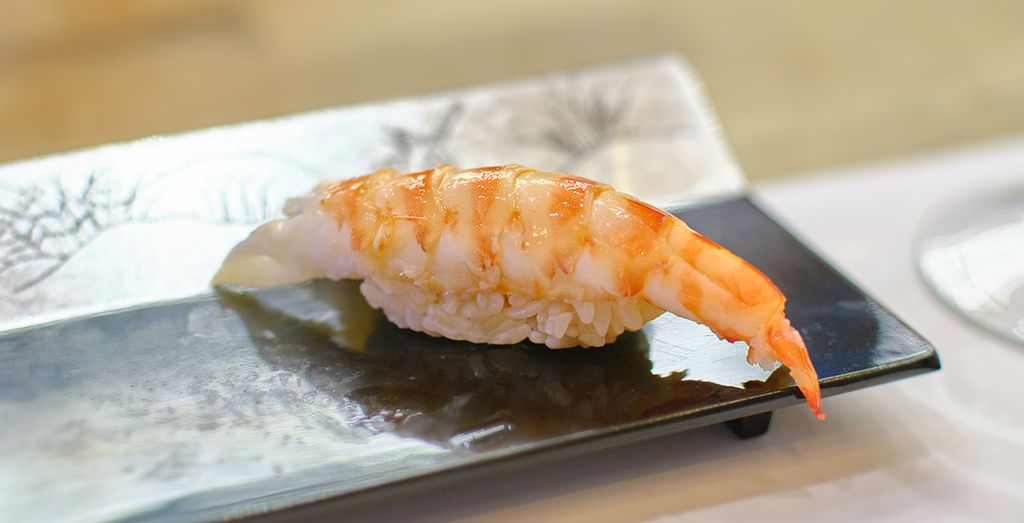
SushiPedia. Ebi Nigiri on Elegant Ceramic Plate. All rights reserved ©
Ebi plays a pivotal role in the culinary tradition of sushi. It is used extensively as so-called handball sushi (nigiri) or — cut into small pieces — as the filling of a sushi roll (maki), baked as ebi tempura or grilled over an open fire.
In truth, ebi is an outstanding nigiri neta who deserves the best place in saramori because it is something that is naturally delicious.
Jiro Ono, Sushi Chef (Sukiyabashi Jiro)[2]
To prevent ebi from curling up during cooking, they are placed on a skewer. Without this preparation, it would not be possible to form the shrimp onto a nigiri. After cooking for a short time, the shrimp are quenched in ice water for a short time. Ebi is most tasty when it is served shortly after preparation, still slightly warm. In addition to a thin glaze of soy sauce, freshly grated wasabi or tomalley, in Japan, known as kanimiso, can also be used as a garnish. Kanimiso is a soft green substance that fulfills the functions of both the liver and the pancreas of the prawn. It has an extremely intense flavor and is considered a special delicacy.
Even small and medium-sized species are caught in significant quantities and are important resources of commercial fishing and a component of Japanese cuisine. Both in terms of taste and ecology, wild shrimp, which have been carefully and sustainably taken from their natural habitat, are preferable to those from industrial aquaculture. High-quality sushi restaurants, with a demand for the highest level of freshness, keep the shrimp alive in tanks (ikesu 生け簀) or boxes until they are prepared. In more “ordinary” sushi restaurants, on the other hand, the shrimp are cooked in the morning, peeled and kept refrigerated until they are served. Very inexpensive restaurants often use pre-cooked and deep-frozen products, but these do not have much in common with the previously mentioned methods in terms of taste.
As diverse as the types of prawns are, their use in Japanese cuisine is just as varied and delicious. The deep-fried, lightly salted head of the botan ebi ボタンエビ, previously coated with potato starch or flour, is considered particularly flavorful. The brain is also considered a very special delicacy. Although most people think of cooked prawns when they hear ebi sushi, they are also highly valued as a raw dish, such as Alaskan pink shrimp (ama ebi アマエビ).
Freshness: The Sweet Taste of Ebi
It is said that the fresher the raw ebi meat is, the sweeter it tastes. The statement that the fresher the raw meat is, the sweeter it tastes is based on biochemical processes that take place in the meat after the animal has been slaughtered. Fresh meat contains natural sugars such as glycogen, which is stored in the animal's muscles. If the meat is processed and consumed quickly after slaughter, a high proportion of this glycogen is retained. Glycogen is a form of stored sugar that is responsible for the sweet taste that is particularly noticeable in very fresh meat. After the animal dies, the process of glycolysis begins, in which glycogen is broken down into lactic acid. This process affects the pH value of the meat and can change the taste. This process not only changes the taste, but also the texture of the shrimp. If prawns are stored for a long time after being caught, the sweet taste decreases and the texture can become tougher. The glycogen content of different species can vary, with some species exhibiting higher levels than others. This variation is partly genetically determined, but the habitat and diet of the species in question can also influence glycogen content. For example, shrimp that live in nutrient-rich waters where they have access to a variety of foods tend to have a higher glycogen content.
Odori ebi 踊り海老, literally: dancing shrimp, describes ebi that is either served live to the guest or killed by the chef shortly before preparation. The term “dancing shrimp” refers to a way of preparing ebi in which they are either served to the guest alive or killed by the chef immediately before preparation. The prawns are peeled alive, and the head is removed first. They are then served directly while they are still twitching on the plate. These muscle contractions, which are triggered by the dying process, create the impression that the prawn is “dancing”. This method of presentation is particularly well-known in Japanese cuisine and is often seen as a sign of freshness and quality.
The Japanese tiger prawn is only suitable for raw preparation to a limited extent, as its raw meat lacks the characteristic intense sweetness of the other ebi species; botan ebi is a tastier alternative.
Gastronomy Challenges of Preparing Ebi in a Western Context
Although ebi is a term for several genera and thus includes many species, the culinary term, only few or high-quality foreign restaurants make a distinction between the Japanese tiger prawn and, for example, a black tiger prawn. Especially outside Japan, the term ebi is used very inflationary for all kinds of shrimp and prawns, which often differ significantly from the kuruma prawn not only in size and taste but also in price. Unfortunately, this is also often due to the fact that, unlike in Japan, many restaurants use standardized menus, which means that the daily or seasonal differences in the purchase of ingredients are not explained.
Unfortunately, ebi sushi, mostly in western countries, does not receive the culinary recognition it deserves. The reason for this is either carelessness or lack of expertise in preparation. If the meat is poached too long, it becomes tough and bland, leaving a shrimp that resembles rubber rather than a delicacy. Ebi is a delicate product whose quality and aromas are quickly destroyed if it is stored for too long or served at the wrong temperature. Freshly caught ebi should be preferred to frozen ones, as their texture is much more pleasing. It is self-evident that a conventional Western sushi restaurant is unable to obtain fresh Japanese tiger prawns. As a customer, you should make sure that you aren't given low-quality farmed shrimp from Southeast Asia.
Types of Ebi for Sushi
In Japan, the term ebi basically covers all types of shrimp. This comprehensive term covers a variety of shrimps that are used in Japan's diverse culinary traditions. However, certain types of shrimp play a particularly important role in the preparation of sushi. These particular species are prized for their special texture, taste, and freshness and are highly valued in sushi gastronomy.
Ama Ebi
The term ama ebi アマエビ refers to a particular type of shrimp, known as “sweet shrimp”, which are highly prized in Japanese cuisine in particular. These are usually the Alaskan pink shrimp (Pandalus eous) or its Atlantic relative, the northern shrimp (P. borealis). The name ama ebi is made up of the Japanese words ama for sweet and ebi for shrimp, which refers to the sweet taste of the meat of this shrimp species.
The skin is soft, and the flesh is easy to remove. When eaten raw, they taste sweet, which is due to the amino acids glycine and alanine. However, the sweetness is not present immediately after capture. Only some time after death, through the process of autodigestion, where proteins are broken down into amino acids, does a sweetness become perceptible. It is usually the case that they are at their tastiest at the time of sale in the store, taking into account transportation time and other factors. Before refrigeration and logistics advanced, cooking in the shell, known as gusoku-ni 具足煮, was common.
Botan Ebi
Botan ebi ボタンエビ, in Japan, primarily refers to Pandalus nipponensis and occasionally closely related species. They are particularly popular because of their sweet, rich taste and buttery texture. The term botan 牡丹 is Japanese for peony, an allusion to the appearance, which is intended to reflect the beauty of the peony. The catch is small and relatively expensive among prawns, so you don't often come across them outside upscale sushi restaurants.
Sakura Ebi
Sakura ebi サクラエビ, translated as “cherry blossom shrimp”, is characterized by its delicate pink coloring, which is reminiscent of Japan's famous cherry blossoms. This small and delicate shrimp species, scientifically classified as Lucensosergia lucens, is mainly caught in the waters around Suruga Bay and is highly prized in Japanese cuisine. The name sakura is derived from the blossom of the Japanese cherry 桜, which is an allusion to the delicate pink coloring of these small shrimp, reminiscent of Japan's famous cherry blossoms. Sakura ebi is fished seasonally, mostly in spring and fall, which makes it a special delicacy that is often eaten fresh.
Kuruma Ebi
Kuruma ebi クルマエビ, also known as Japanese Tiger Prawn, is a highly prized shrimp species in Japanese cuisine, known for its intense flavor and firm texture. The name kuruma ebi is derived from kuruma, meaning “wheel”, and alludes to the size and striking pattern of the shrimp, which may resemble the spokes of a wheel. This shrimp species, scientifically known as Marsupenaeus japonicus, is mainly found in the waters around Japan and other parts of Asia. Kuruma ebi is particularly prized for its size and quality, and is therefore often more expensive than other shrimp species. In Japanese cuisine, it is typically cooked and then served as sushi. The prawn is carefully prepared to preserve its textural integrity and subtly sweet taste.
Names of the Kuruma Ebi
The name of kuruma ebi differs in Japan gastronomy depending on the size. The classes into which shrimp are divided according to size vary from region to region. In general, the following subdivisions can be made:
| Name | Length |
|---|---|
| Saimaki (サイマキ) | Less than 13 cm |
| Maki (マキ) | 13 to 15 cm |
| Kuruma (クルマ) | 15 to 20 cm |
| Dai-Kuruma (大クルマ) | More than 20 cm |
For use as nigiri sushi, the size of maki and kuruma are preferred.
Ebi in Japan
In Japan, ebi has long been a popular ingredient for good omens and luck, for example in New Year's cooking, and even appears in some proverbs. One well-known proverb is ebi de tai o tsuru 海老で鯛を釣る, which literally means “catching a sea bream with a shrimp”. This proverb symbolizes that you can achieve great profits or success with little effort or a small investment. The proverb, ebi o kū mukui 海老を食う報い, emphasizes that although the pleasure of shrimp is delicious, it does not last forever, indicating the transience of good times and that every high can be followed by a low. Another proverb ebi to na no tsuku karō dono 海老と名のつく家老殿refers to people who are outwardly impressive and authoritative, but do not possess the appropriate qualities or abilities. It means that someone offers a lot of appearance and little substance, comparable to a shrimp shell that looks impressive but offers little content. This proverb thus criticizes a superficial appearance without substantial substance.
Ethymology
In ancient Japan, grapes were also called ebikazura 葡萄蔓or simply ebi. Therefore, objects with a grape-like, red-violet color were described as ebi-iro えび色. It is therefore assumed that shrimps were called ebi because they had this ebi-iro color. The Japanese characters for ebi 海老 are made up of the character for “sea” 海 and “old age” 老. This combination is an allusion or allegory to the curved back and the antennae, which are reminiscent of an old man's beard.[3]
Characteristics & Ecology of Ebi
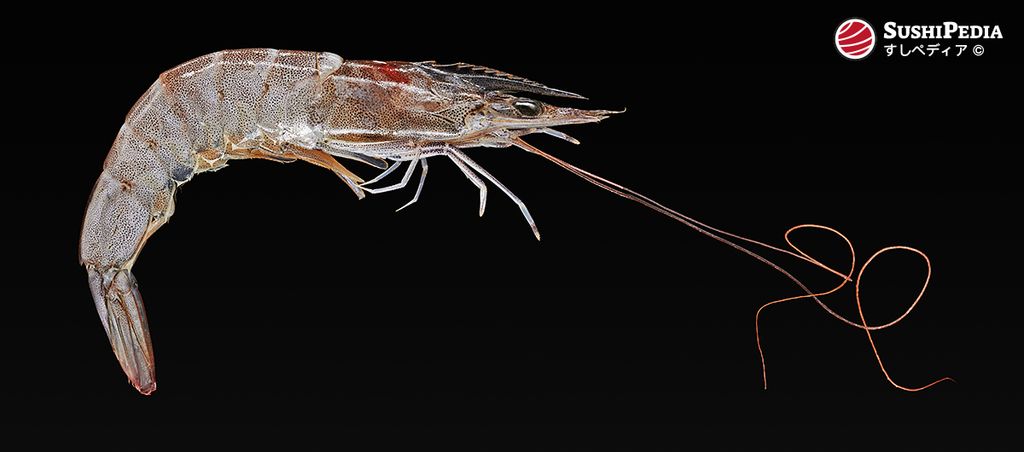
SushiPedia. Ebi Sushi Ingredient: Top View of a Whiteleg Shrimp. All rights reserved ©
Prawns or shrimps species, ranging from the famous kuruma shrimp to other lesser-known varieties, are an essential part of the marine fauna. The spectrum of prawns or shrimps includes an astonishing variety of species. These range from smaller, almost transparent shrimps to larger, brightly colored specimens. Each species has its own unique characteristics. Many of them go through complex life cycles that include both pelagic (free-swimming) and benthic (bottom-dwelling) stages.
Prawns or shrimps have an elongated, more or less cylindrical and laterally slightly compressed body with a thin shell. They have long antennae (feelers) and only delicate grasping organs (claws). The legs at the back of the body are transformed into swimming organs. The head usually forms a projection (rostrum) that is extended forwards. Shrimps can have a wide range of colors, from almost transparent to strong red or blue tones. These colors can change depending on their habitat and diet, giving them an added dimension in presentation and aesthetics.
Taxonomic and Ecological Distinctions Between the Term “Shrimp” and “Prawns”
The vernacular terms “prawn” and “shrimp” are often used interchangeably, which is justified by their similarity. Both belong to the order of “ten-footed” crustaceans (Decapoda), which are characterized by their ten-legged structure and exoskeletal anatomy. These crustaceans live predominantly on the substrates of their respective aquatic habitats and exhibit comparable morphological characteristics. Shrimp and prawns are both categorized under the order Decapoda but are classified into different suborders based on distinct anatomical features, particularly their gill structures. Shrimp are primarily found in the suborder Pleocyemata, which includes the infraorder Caridea, characterized by lamellar gills. Prawns, on the other hand, belong to the suborder Dendrobranchiata, which includes the infraorder Penaeidea. This infraorder is known for its branching gill structure and encompasses species commonly referred to as either shrimp or prawns. The overlap in terminology within the infraorder Penaeidea demonstrates how common names do not strictly adhere to scientific classifications and can vary significantly depending on regional and culinary contexts. While there is a tendency to associate certain types of shrimp with saltwater and certain prawns with freshwater, both groups can be found in both environments depending on the species. The generalization that prawns prefer freshwater primarily applies to certain families and does not represent all prawns globally.
Taxonomic Restructuring of the Genus Penaeus
The taxonomic reclassification of the genus Penaeus is based on a proposal by Pérez Farfante and Kensley, which is based on morphological differences. As a result of this revision, many species that formerly belonged to Penaeus were assigned to new genera within the family Penaeidae: Farfantepenaeus, Fenneropenaeus, Litopenaeus and Marsupenaeus.[4] As the reclassification is not yet fully recognized by the scientific community, this article uses the currently valid taxa until it is generally accepted.[5]
Economy of Ebi
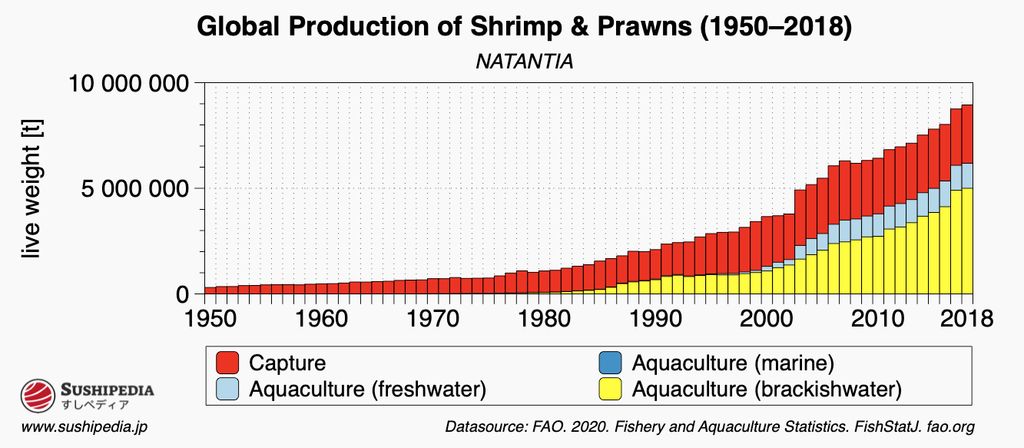
SushiPedia. Global production of shrimp by fishing method from 1950 to 2018. All rights reserved ©
The economics of prawn or shrimp play a significant role in the global fisheries market and influence both local and international economies. Prawn or shrimp is one of the most traded seafood products in the world, making it an important economic factor, especially in coastal regions and countries with strong fishing industries. The catch and trade of prawn or shrimp includes both wild fisheries and aquaculture, the latter of which has become increasingly significant in recent decades to meet growing demand and reduce overfishing of natural stocks. Nevertheless, this industry is confronted with a number of challenges, including environmental concerns, the need for sustainable management, and the necessity of ensuring socio-economic fairness for communities engaged in fishing.
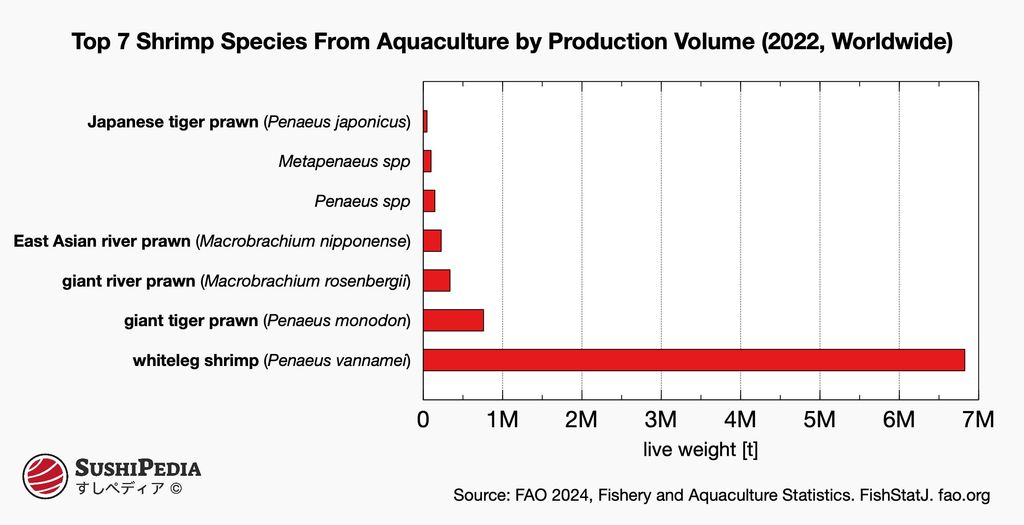
SushiPedia. Global aquaculture production of shrimp species in 2022. All rights reserved ©
Shrimp or prawn, which come from both wild fisheries in the northern and southern hemispheres and aquaculture, are one of the most popular seafood products among consumers worldwide. Major markets for shrimp include the United States, Japan, and the European Union, reflecting its universal appeal and consumption. From an economic perspective, shrimp can be divided into two main categories: Cold-water and warm-water shrimp. Cold-water shrimp, including the northern shrimp (Pandalus borealis), are mainly caught in the Northern Hemisphere and are not suitable for aquaculture. In contrast, warm-water prawns are obtained from both wild fisheries and aquaculture. Species such as the giant tiger prawn (Penaeus monodon) and the whiteleg shrimp (P. vannamei) are the species that lead aquaculture production. This development has led to a significant increase in the overall supply of warmwater shrimp, making them a staple food in both retail and gastronomy worldwide. Despite the increased production and improved availability, shrimp is still considered a high-value commodity, often considered a luxury item, and continues to experience strong demand from consumers and the industry.[6]
Season Calendar for Ebi
The calendar shown does not provide information on fishing times, but marks the periods in which ebi is considered particularly tasty.
Video about Ebi Sushi
External video embedded from: youTube.com. Credit Japanese Eats. Sushi Yoshitake - Ebi (Shrimp).
Species of Ebi
The following species are regarded as authentic ebi. Either historically, according to the area of distribution or according to the common practice in today's gastronomy: The term ebi encompasses a variety of species that are grouped together under these names. Due to the extensive diversity of these species, it is not always possible to list all specific taxa in this list completely.
In the following, those species are listed that can be considered as substitutes for authentic species with regard to ebi. This can be based either on their genetic relationship or on their similarity in taste and appearance. The selection is subjective and is not strictly based on Japanese conventions, but also takes into account the practices in the respective areas where the Japanese dishes are prepared. This flexible approach allows for adaptation to local availability and preferences while preserving the core flavor and texture traditionally associated with ebi.
Sources and Further Reading
- [1]Yoshino Masuo. Sushi. Gakken Co. Ltd., Tokyo. 1987
- [2]Shinzo Satomi. Sukiyabashi Jiro. Vertical Inc., New York. 2016
- [3]フリーランス雑学ライターズ. 『フリーランス雑学ライターズ 編『あて字のおもしろ雑学』』. 永岡書店, Tōkyō. 1988
- [4]Isabel Perez Farfante, Brian Kensley. Penaeoid and Sergestoid Shrimps and Prawns of the World. Keys and Diagnoses for the Families and Genera. Memoires du Museum National d'Histoire Naturelle Vol. 175. Muséum National d'Histoire Naturelle, Paris (France). 1997
- [5]Patsy A. McLaughlin, Rafael Lemaitre, Frank D. Ferrari, Darryl L. Felder, R.T. Bauer. Letter to the Editor A reply to T.W. Flegel. Aquaculture 275 370-373. 2005. DOI: 10.1016/j.aquaculture.2007.12.020.
- [6]PingSun Leung, Carole Engle. Shrimp Culture: Economics, Market, and Trade. First edition. Blackwell Publishing Professional, Iowa (USA). 2004
- Celeste Heiter. The Sushi Book. Things Asian Press. 2007
- Dave Lowry. Connoisseur's Guide to Sushi: Everything You Need to Know About Sushi Varieties And Accompaniments, Etiquette And Dining Tips And More. The Harvard Common Press, Boston. 2005
- Jack Seward. Outrageous Japanese (言ってはいけない!!危ないにほんご). Tuttle Publishing, North Clarendon. 2006
- Kazuko Masui, Chihiro Masui. Sushi Secrets. Hachette Illustrated, London. 2004
- Lindsay G. Ross. Prawns of Japan and the World. CRC Press, Boca Raton. 2001
- Raymond T. Bauer. Remarkable Shrimps: Adaptations and Natural History of the Carideans, Animal Natural History Series Vol. 7. University of Oklahoma Press, Oklahoma. 2004
- Richard Hosking. A Dictionary of Japanese Food: Ingredients & Culture. Tuttle Publishing, North Clarendon. 2015
- Theodor C. H. Cole. Wörterbuch der Wirbellosen / Dictionary of Invertebrates: Latein-Deutsch-Englisch. Springer Berlin Heidelberg. 2016
- 『ボタンエビの食べ方』. らっしゃい!かに市場. Source retrieved 4/24/2024
- IUCN Red List of Threatened Species. Version 2023-1
Image Credits
- SushiPedia. Global aquaculture production of shrimp species in 2022. All rights reserved ©
- SushiPedia. Ebi Sushi. All rights reserved ©
- SushiPedia. Global production of shrimp by fishing method from 1950 to 2018. All rights reserved ©
- SushiPedia. Ebi Sushi Ingredient: Top View of a Whiteleg Shrimp. All rights reserved ©